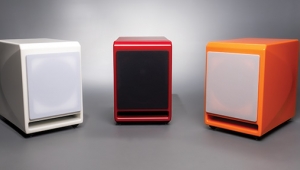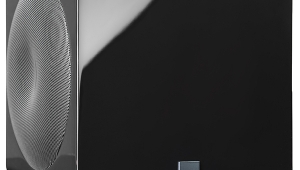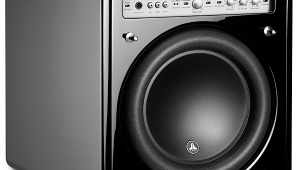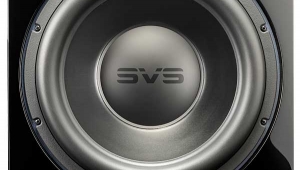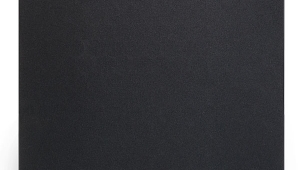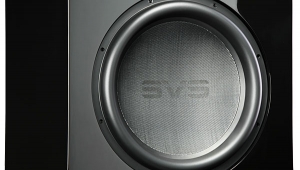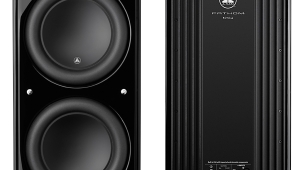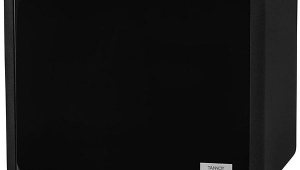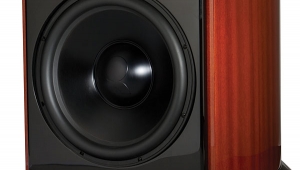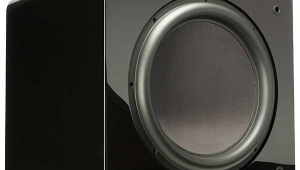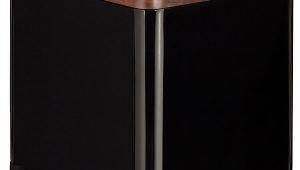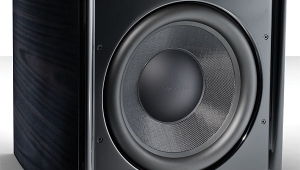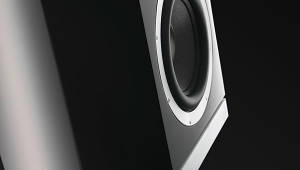| Columns Retired Columns & Blogs |
Thiel SmartSub SS1 subwoofer
"Subwoofers are boring," whined John Atkinson when we were dickering about column inches for my review of the Thiel CS2.4 loudspeaker in this issue. "I know they're important, but I just don't get excited reading about them."
I knew what he meant. The typical subwoofer has a beefed-up driver(s) and a run-of-the-mill amp-crossover module all too frequently purchased off the shelf at www.subwoofermodulesrus.com. Oh, you do get flavor variations: forward-firing vs downfiring, class-D vs linear amp, and the ever-popular trio of ported vs sealed vs isobaric enclosure. Yawn.
But the SmartSubs are the products of Jim Thiel, a man with his own ideas about everything. "I think subwoofers usually just sound horrible, so I wasn't interested in making a product I wouldn't like."
So what prompted him to design not only a subwoofer, but an entire line of them, not to mention several passive crossovers and an active crossover-integrator?
"Ignorance! Had I known how big a project it would be and how long it would take, I would have never felt confident about devoting all that time and resources to it."
The problem, as Thiel saw it, wasn't the subwoofer itself—even if he designed a subwoofer that satisfied him with its frequency response, high output, and low distortion, it was still liable to sound "horrible"—but with the one-size-fits-all approach to integrating the outputs of the subwoofer and the main speakers with the acoustics of the room they have to perform in.
"Take a speaker like, let's say, a CS1.6," said Thiel—"a two-way speaker with a pretty good crossover. Even a relatively unsophisticated observer would probably hesitate to remove that crossover and use it in a completely different loudspeaker with different drivers, a different-sized enclosure, and so on—and that's the kind of situation that subwoofers are in with processor-based management or the generic crossovers built into the backs of most of them. And, as you know, crossovers are something I have strong opinions about.
"Instead of trying to figure out the filter characteristics you want, I thought we should start with the signal that represents the output you want from the combination of the sub plus the main speaker. To oversimplify, that would be the input signal, and you subtract from it the part that the main speakers will reproduce—you electronically construct an analog of your main speakers that has the same [low-frequency] output characteristics, the same rolloff characteristics, and you take that signal and subtract it from the main input signal. What you are left with, by definition, is whatever the subwoofer will need to put out to blend with the main speakers to produce the desired result. That's the insight that got me excited about the subwoofer project."
Toward this end, Thiel developed a different set of subwoofers. They are typical of all Thiel designs in featuring Thiel-designed and -built high-excursion aluminum drivers that use the firm's short-coil, long-gap motor system. The models differ mainly in the sizes and numbers of drivers: the SmartSub SS1 has a single 10" driver, the SS2 has two, the SS3 has two 12" drivers, and the SS4 two 15" drivers. The SS1 ($2900), which I auditioned, also differs from the rest in that it has a 500W linear class-A/B amplifier with a tracking switching power supply, instead of the 1000W module that comes with the others.
What none of the SmartSubs comes with is a crossover. You need to add one of Thiel's passive models, all of which are configured for use with Thiel main loudspeakers and are available in two- and five-channel versions; or Thiel's active S1 Integrator-crossover; or you could use your surround-sound processor's LFE output and break Jim Thiel's heart.
The amplifier modules on the SmartSubs look like those on other subwoofers, but the controls aren't there to set rolloff, phase angle, or crossover point—they instead allow you to set environmental parameters, such as distance from the side and rear walls, in addition to LFE extension. Input is limited to an RCA connection for LFE signal reception or balanced XLR to one of the Thiel crossovers.
The PX02 external crossover ($350) is also quite different from the run of the mill. To begin with, it's not a crossover but an integrator. You get one configured to your Thiel main speakers—and PX02s are offered only for Thiel main speakers. "It took over a month of engineering time to do the seven models I designed—I don't have the time to do hundreds of models," Thiel explains.
To connect a PX02 to your system, you run a second pair of speaker wires from your amplifier ("and they don't need to be high-quality cables, either," Thiel added). The PX02 subtracts its analog of the main speakers and passes on the remaining information to the SmartSub. The main speakers play full-range, the subwoofer augments their output.
The S1 Integrator-crossover is far more flexible and can be used with any speaker. It can be inserted between the preamp and amplifier or receive input at the speaker level, and it can work in one of two modes: Crossover or Augment. Which you use will depend on your main speakers, Thiel suggests: large, full-range loudspeakers work best with Augment; smaller speakers may do better with Crossover. Fortunately, the S1 can store six different settings, so you can store both and use the S1's remote control to compare and contrast from your listening seat.
The S1 is almost infinitely flexible. You enter information concerning your system, including the sensitivity of your main loudspeakers, enclosure type, low-frequency limit, and damping. Add a few more parameters, such as the gain of your amplifier, your preferred low-frequency extension, and your preferred crossover point (if you're using it in crossover mode). Some of this information is fairly straightforward (you'll know if your speakers have a sealed or reflex enclosure), some you may need to look up (Thiel posts a fairly comprehensive base of speaker data on their website), and some you may need to experiment with.
I initially set the crossover as low as possible, thinking I should let the Thiel CS2.4s do as much of their stuff as possible. I didn't hear as much bass enhancement as I'd thought I should get, so I kept setting it higher. Finally, when I reached 80Hz, I seemed to click in to the magic spot. Thiel later suggested that 10Hz above a speaker's –3dB down point seems to be a good rule of thumb; my 80Hz is quite a bit higher than that.
The question is, how much difference will a single 10" driver make with a full-range speaker such as the CS2.4, which already has pretty good bass extension? Plenty! And not all of it where I expected, either.
First, if you're using Thiel speakers as your mains, the PX02 is one heck of a deal. For $350 plus a cheap set of speaker cables and a plain-vanilla XLR cable from my home studio's mess o' wires, I got more bass, which I reckoned was the whole point of the thing. That bass was tauter, went about half an octave deeper, and was perfectly in sync with the rest of the music—in fact, I kept walking over to the SS1 and putting my hand on its lid to determine that it was still on. No sound came from the sub itself, or so it seemed—everything just sounded bigger and better. "The Mooche," from the Jerome Harris Quintet's Rendezvous (CD, Stereophile STPH013-2), glided along on some of the deepest bass burbles I've ever heard from this disc.
But when I used the S1 Integrator-crossover in crossover mode, I was stunned at the transformation. Art Baron's trombone mutters were brighter and richer than I'd heard them even 10 minutes before, with the PX02. And Marty Ehrlich's soprano sax had brassy sawteeth I was sure weren't there before. Sure, there was more bass, but everything sounded so much better.
Well, duh. If a subwoofer is correctly mated to a main speaker, it's the sonic equivalent of losing 50 lbs— everything gets easier because there's less strain all around. Freed of the heavy lifting, the CS2.4s were able to shine, not just in the low frequencies, but in the middle and on top, too. It was a remarkable enhancement in a loudspeaker I was already pretty besotted with.
But it came at quite a hefty price. The SS1 cost $2900, the S1 $4400. Add interconnects, and the Thiel subwoofer system costs nearly twice as much as the main speakers I started out with. Who would do such a thing?
No one, I suspect—at least, no one would buy the CS2.4s and the SS1-S1 combo at the same time. After all, you can buy a pair of Thiel CS6s for less than that. But I could see someone who already owned a pair of CS2.4s and loved 'em adding an SS1 and a PX02. Heck, maybe even an S1, if such a person thought he might want to add a second SS1 at some point.
I suspect, however, that the real customer for Thiel's S1 and SmartSubs is someone who owns a different company's loudspeakers and loves 'em inordinately, except for a slight sense of bass inadequacy. Intelligently integrating real bass into the sound of a beloved loudspeaker is something that might enter that much-mythologized territory of "more important than money."
Actually, in the face of that kind of musical bliss, money doesn't really seem like all that much to ask.
- Log in or register to post comments
